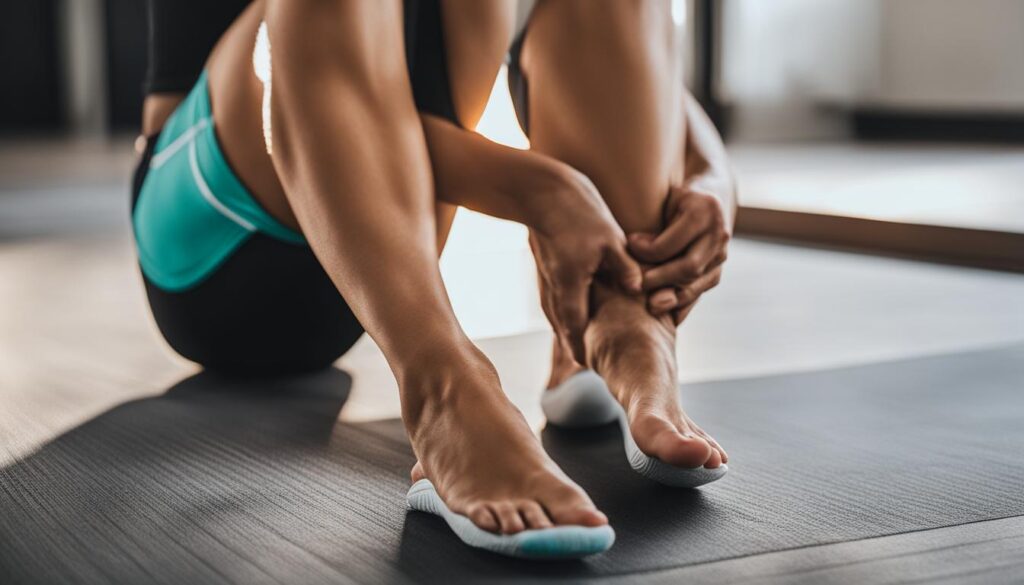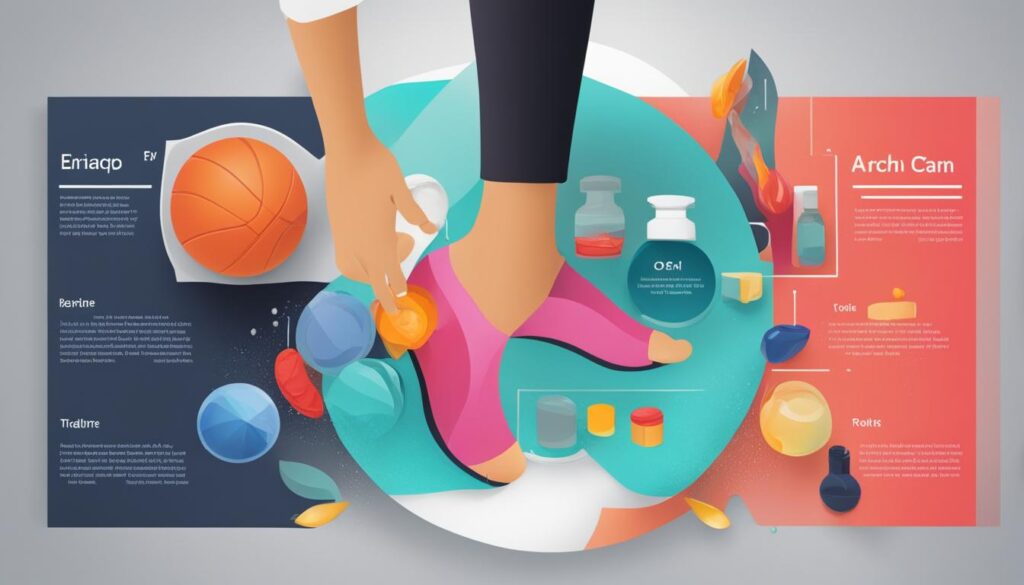Foot arch cramps that arise unannounced can hamper everyday pursuits or physical activities. These sudden tetany occurrences can stem from a vast array of triggers, including ill-suited footwear, dehydration, muscle strain due to strenuous exercise, a lack of potassium causing electrolyte imbalances, peripheral neuropathy, and even certain medications’ side effects. Familiarizing yourself with effective foot arch cramp treatment options and preventive measures can help you manage this discomfort and resume your day-to-day activities unhindered.
The myriad choices available for arch cramp relief range from immediate interventions to long-standing prevention strategies. Further, identifying your cramp triggers could lead you toward targeted treatment techniques and remedies. Together, this comprehensive approach can empower you to tackle foot arch cramps and ensure they don’t let you off stride.
Key Takeaways
- Foot arch cramps are muscle spasms that can disrupt daily activities and physical exertion.
- Inappropriate footwear, dehydration, overexertion, low potassium, peripheral neuropathy, and certain medications are common triggers of foot arch cramps.
- Understanding these triggers aids in finding suitable foot cramp remedies and preventive actions.
- Immediate relief for arch cramps can be sought through techniques such as stretching, walking, massages, or applying ice or heat.
- Foot arch cramp treatment and prevention centers around adequate hydration, proper footwear, regular stretches, and a balanced diet.
- Prolonged or reoccurring foot arch cramp issues merit medical attention to rule out deeper underlying health problems.
Understanding the Causes of Foot Arch Cramps
Foot arch cramps tend to strike when you least expect them, often leaving you in discomfort and searching for immediate relief. The cause of these troublesome cramps can be attributed to a variety of factors such as wearing tight shoes, dehydration, overexertion, and certain medical conditions. Let’s delve deeper into understanding these causes to aid in preventing foot arch cramps, treating arch cramps, and relieving foot cramps.
Too-Tight Shoes and Restricted Movement
Tight shoes can restrict movement and affect circulation, leading to muscle cramping. Constant pressure on feet can lead to discomfort, which may eventually turn into foot arch cramps. If you’re wondering how to stop foot arch cramps, one simple step you could consider is wearing shoes that are comfortable and well-fitted, providing your feet with ample space to move.
Dehydration and Its Impact on Muscle Function
Dehydration, especially during strenuous physical activities, can cause improper muscle function, resulting in spasms and cramps. Sufficient fluid intake is a critical aspect of foot cramp prevention as it helps maintain normal muscle function and prevent electrolyte imbalances.
Overexertion and Muscle Strain
Pushing our muscles too hard during exercise or not being adequately conditioned can cause overexertion-related cramps. Gradual conditioning, regular stretching exercises and breaks during rigorous activities can help prevent these cramps.
Electrolyte Imbalances: The Role of Potassium
Did you know that low levels of vital electrolytes such as potassium can lead to cramping in the feet and legs? Keeping a balanced intake of potassium-rich foods may therefore provide an effective approach in preventing foot arch cramps.
Peripheral Neuropathy and Nerve Damage Concerns
Peripheral neuropathy, often seen in conditions such as diabetes, can cause foot discomfort which may at times be misinterpreted as foot arch cramps. Such nerve damage can mimic the pain of foot cramps, emphasizing the importance of proper diagnosis for effective treatment.
The Side Effects of Certain Medications
In some cases, foot arch cramps can be a side effect of certain medications. Statins, diuretics, and medications for conditions such as asthma and high blood pressure, are known to cause cramping. In such instances, a consultation with a healthcare professional can provide appropriate guidance and therapy adjustment, if necessary.
Taking into consideration the listed causes and potential triggers can help in understanding, preventing, and even treating arch cramps effectively. With better knowledge, you can take proactive measures and embark on your journey of foot cramp prevention.
| Causes of Foot Arch Cramps | Recommended Solutions |
|---|---|
| Tight Shoes | Wear well-fitted and comfortable shoes |
| Dehydration | Stay sufficiently hydrated, especially during physical activities |
| Overexertion | Take adequate breaks during workouts and ensure gradual muscle conditioning |
| Low Potassium Levels | Maintain balanced intake of potassium-rich foods |
| Peripheral Neuropathy | Seek medical advice for proper diagnosis and treatment |
| Medication Side Effects | Consult healthcare professional for medication assessment and adjustment if necessary |
Immediate Remedies for Arch Cramp Relief
Foot arch cramps can be excruciating and distressing, but thankfully, prompt arch cramp relief is possible with a few simple interventions. Regardless of when these cramps strike, following these straightforward foot arch cramp solutions can provide swift relief and rapidly restore mobility.
Let’s dive into these immediate foot cramp remedies:
- Stretching: Gently stretch the affected muscle. Holding the stretch for around 30 seconds can help lessen the cramp.
- Mobility: If you’re able to move, walking or standing can often help alleviate the immediate tension and ease a cramp.
- Massage: A deep tissue massage often provides immediate relief by relaxing the muscles and increasing blood flow.
- Cold Application: Applying a cold pack to the cramped muscle can reduce inflammation and ease pain.
- Heat Application: Alternatively, using a warm towel or heat pack can also relax the muscle, easing the intensity and duration of the cramp.
With these simple and readily accessible foot arch cramp solutions, dealing with sudden cramps can be significantly less distressing.

Hydration: Effective Prevention against Cramps
Prevention starts with hydration. Especially during physical activity and in hot weather, it is key to remain properly hydrated. Not only does this prevent general dehydration and a sluggish feeling, but also helps prevent muscle cramps from developing.
The Importance of Proper Footwear
Just as crucial as hydration, is the type of footwear you select. Shoes that are too tight or don’t fit properly can constrict blood flow and restriction toe movement, both of which can lead to foot cramps. Opt for comfortable, well-fitting shoes to give your feet the space they need.
Stretching and Warm-Up Techniques
Flexibility is another key aspect of foot cramp prevention. Regular stretching exercises, ideally prior to physical activities and before bedtime, help warm up your muscles and ward off cramps. Whether it’s simple toe stretches or more comprehensive lower limb stretches, keeping muscles limber helps to prevent cramping.
Diet Considerations for Muscle Health
Last but not least, your diet can also affect your foot health. A balanced diet rich in electrolytes such as potassium, magnesium, and calcium can assist in sustaining muscle health and preventing cramps. So, make sure to fill your plate with lots of fruits, veggies, and lean proteins to keep your foot muscles healthy and cramp-free!
In summary, these preventative strategies can be a game-changer in managing your foot health. By incorporating these changes into your lifestyle, you could drastically reduce your foot cramp occurrences, leading to a more comfortable and affirming experience when carrying out your usual activities.
When to Seek Medical Attention for Foot Cramps
Occasional foot cramps might be a common annoyance, but chronic or debilitating cramps should not be ignored. These could be indicative of an underlying health condition that requires medical attention. Recognizing the signs that warrant a consultation with a healthcare provider could lead to effective foot arch cramp solutions and greatly improve your quality of life.
Chronic Versus Occasional Cramps: When to Worry
While occasional foot cramps can often be managed with home remedies, chronic foot cramps that persist despite efforts at relief might signify an underlying health issue. If you’re frequently plagued by foot cramps, or if your cramps are severe enough to disrupt your daily activities, it’s time to seek professional arch cramp relief.
Spotting Symptoms of Severe Dehydration and Electrolyte Imbalance
Severe dehydration and electrolyte imbalances, such as hypokalemia, can cause cramping in your feet. Symptoms of severe dehydration include dry mouth, chills, and concentrated urine. If you’re experiencing these symptoms along with persistent foot cramps, medical intervention is crucial.
Identifying Signs of Peripheral Neuropathy
Peripheral neuropathy, a condition often associated with diabetes and other conditions, can lead to foot discomfort mistaken for cramps. If you’re experiencing a burning or numb sensation in your feet alongside your cramps, it’s imperative to consult with your healthcare provider, as these could be signs of peripheral neuropathy.
Medication-Induced Cramps: Navigating Treatment Changes
Some medications, including statins, diuretics, and drugs for asthma or high blood pressure, can cause foot cramps as a side effect. If you suspect your foot cramps are caused by your medication, it’s important to consult with your doctor. They can assess the situation and possibly adjust your treatment to alleviate the issue, thus providing appropriate foot cramp remedies.
In conclusion, persistent, recurring, or severe foot arch cramps should be evaluated by a healthcare professional. Prompt consultation and appropriate treatment can not only offer relief from the discomfort, but also improve your overall health and well-being.
Conclusion
In conclusion, the journey to effective foot arch cramp treatment and arch cramp relief begins with a clear understanding of the various causes behind these painful occurrences. The power to mitigate the discomfort associated with foot cramps lies in simple, yet strategic interventions. These can range from immediate remedies such as stretching and hydration, to more long-term strategies such as assessing one’s footwear and dietary habits.
There are several ways of preventing foot arch cramps and treating arch cramps. Regular physical activity aids in improving muscle strength and flexibility, while proper hydration ensures normal muscle function. A balanced diet rich in essential nutrients helps avoid electrolyte imbalances, a known culprit behind muscle cramps.
However, when foot cramps become a persistent annoyance or start interfering with daily activities, it is crucial to seek professional help. Nbavigating the world of foot cramp remedies alone can be overwhelming, and underlying health issues could be causing the discomfort.
By acknowledging the importance of foot health and taking informed, proactive steps, it becomes possible to bask in the comfort and enhanced mobility that a life free from foot arch cramps promises. Here’s to enjoying every step of your journey!





